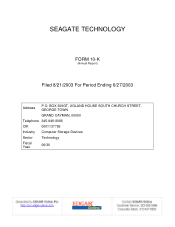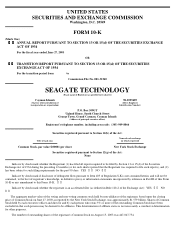Seagate 2002 Annual Report Download - page 5
Download and view the complete annual report
Please find page 5 of the 2002 Seagate annual report below. You can navigate through the pages in the report by either clicking on the pages listed below, or by using the keyword search tool below to find specific information within the annual report.
Industry
Demand for Electronic Data Storage
We believe that the amount of data stored and accessed electronically is growing rapidly and that there are a number of key factors
driving this demand, including:
•
the continuing expansion of the Internet as a medium for information technology infrastructure related to business management, for
broadband communication and for entertainment, particularly music and video;
•
the widespread adoption of enterprise software applications, such as supply chain management, customer relationship management,
enterprise resource management and data warehousing;
•
a broader deployment of information storage systems that allow rapid recovery of data following a disaster and that increase data
availability to end users by creating multiple distributed copies; and
Rigid disc drives are the primary devices used for storing, managing and protecting the electronic data associated with all of these applications.
We are particularly focused on three areas of growing demand for rigid disc drives:
Growth in Rigid Disc Drives for Consumer Electronics . High-performance computing and communications functions and, increasingly,
rigid disc drives are being incorporated into consumer electronics such as video game consoles, including Microsoft’s Xbox, digital video
recorders and advanced television set-top boxes. In addition, faster connections to the Internet and increased broadband capacity have
encouraged consumers to download greater amounts of text, video and audio data, expanding the market for rigid disc drives for use in new
consumer and entertainment appliances. The adoption and rapid growth of the use of rigid disc drives in these applications will be facilitated by
the development of low-cost rigid disc drives that meet the pricing requirements of the consumer electronics market.
Growth in Rigid Disc Drives for Notebook Computers. The notebook computer market is expected to grow faster than any other PC
segment as performance and price continue to improve, placing notebooks in an attractive position relative to desktop computers. Notebook
systems are increasingly becoming replacement systems to desktop PCs and progressively more desirable to consumers as the need for mobility
increases and wireless adoption continues to advance. In addition, the industry continually progresses towards smaller systems and devices.
Growth of Storage Area Networks and Network Attached Storage . The need to address the dramatic expansion in data storage
management requirements has spurred the evolution of new storage and data management technologies. Enterprises are increasingly offloading
network traffic to dedicated storage area networks, or SANs. In addition, many enterprises are moving away from the use of server-attached
storage to network-attached storage, or NAS. These solutions combine high-performance storage products that are comprised principally of
rigid disc drives with sophisticated software and communications technologies. We expect that the market for these solutions will grow rapidly
and will result in greater opportunities for the sale of high-performance, high-capacity rigid disc drives.
Success in Our Industry Depends on Technology and Manufacturing Leadership
•
the continuing growth in software applications, such as databases and computer aided design programs, used by individuals and small
groups that are delivered over a network from shared data servers.
The design and manufacturing of rigid disc drives depends on highly advanced technology and manufacturing techniques, especially in
the areas of read/write heads and recording media. Rigid disc drive manufacturers are distinguished by their level of integration, which is the
degree to which they control the technology used in their products, and by whether they are captive, producing rigid disc drives for their own
computer systems, or independent. Integrated manufacturers are companies that design and produce the critical technologies, including
read/write heads and recording media, used in their rigid disc drives. An integrated approach enables them to lower manufacturing costs and to
improve the functionality of components so that they work together efficiently. In contrast, manufacturers that are not integrated purchase most
of their components from third-party suppliers, upon whom they depend for key elements of their technological innovation and differentiation.
This can limit their ability to coordinate technology roadmaps and optimize the component design process for manufacturing efficiency and
product reliability while making them reliant on the technology investment decisions of their suppliers. Independent manufacturers can enjoy a
competitive advantage over captive manufacturers in working with original equipment manufacturers, or OEMs, because they do not compete
with OEMs for computer system sales.
3


















